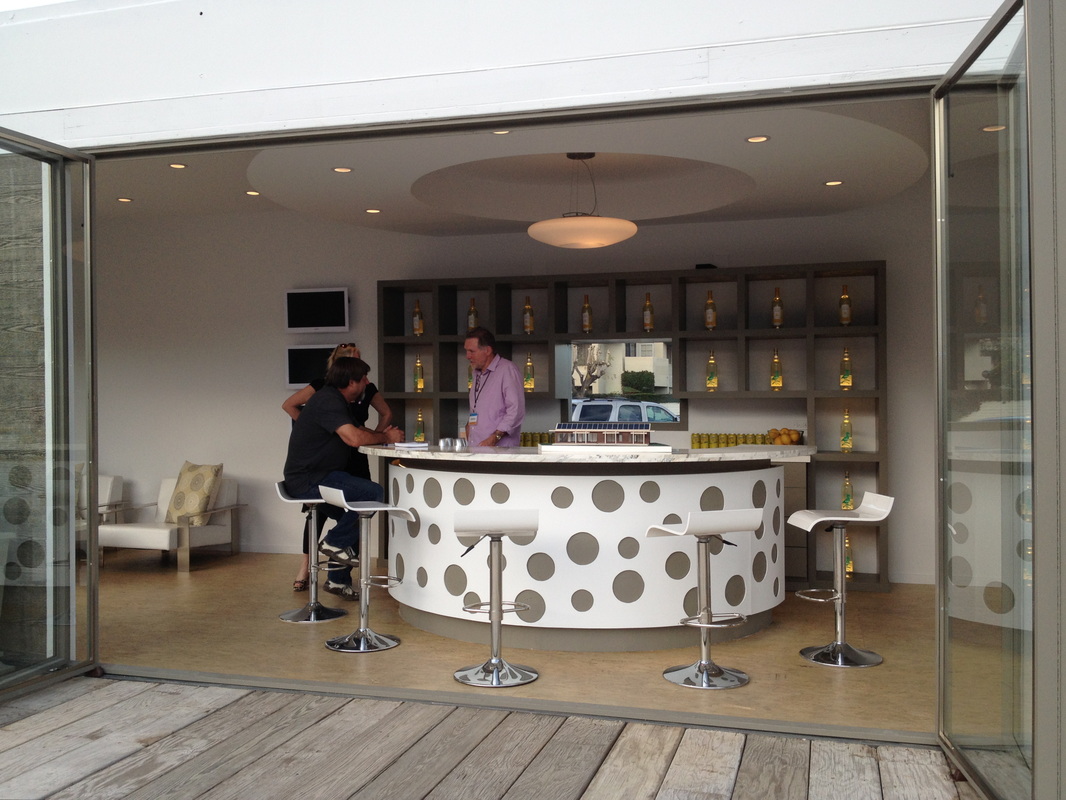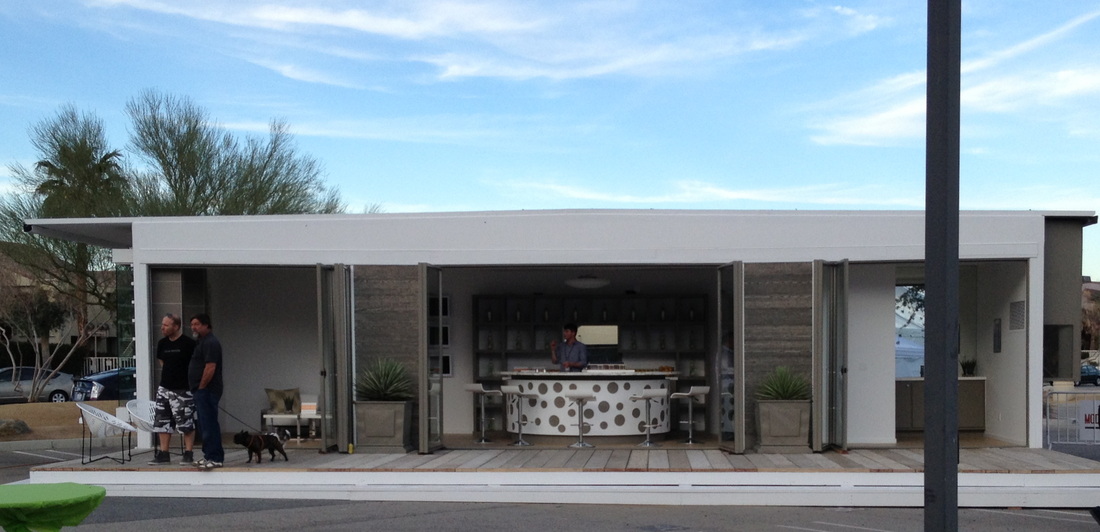|
One Of Many Exhibits From MW • Prefabricated Housing Recycled From Discarded Schoolhouse Modular Buildings Built By Architect Robert Anderson If you have not heard of this popular and expanding annual event, chances are you will in the future. For 11 days the famous desert resort city hosts a series of lectures, films, cocktail parties, fundraisers, exhibitions and vendor promotions which celebrate the growing obsession with modern architecture, interiors, furniture and industrial design. There is even an exhibit this year on the sadly lost world famous airline, Pan Am, so associated with the mod culture of the times.
How did this begin in Palm Springs? The small town of about 45,000 residents is a gold mine of mid-century modern architecture. It started in the 1950s when Southern California's post WWII economy boomed and an incredible architectural experiment called "The Case Study Houses" defined an optimistic and progressive cultural phenomenon unlike any seen since. Famous architects such as Charles Eames, Richard Nuetra, Pierre Koenig and Rudolf Shindler contributed brilliantly to the Case Study program offering young and upwardly mobile families a chance to create lifestyles that truly engaged and appreciated the beautiful and gentle California climate and that expressed the celebration and expanding freedom that the new modern life offered. Cutting edge real estate developers capitalized on the blossoming trend by hiring lesser known architects to design new homes that were built in single developments of hundreds at a time. One developer, Joseph Eichler, built mostly in the San Francisco Bay Area but managed to expand to the Southland completing in total over 11,000 homes in the Golden State. These houses are revered by many enthusiasts and affectionately referred to as "Eichlers". And in Palm Springs the most prolific and locally famous developer was the Alexander Company; these houses are affectionately referred to as "Alexanders". The Company built well over 2,000 new houses between 1955 and 1965. That is quite a significant contribution considering that the population of the resort city was only about 15,000 full time residents. What is really fascinating about this movement is that these architectural fashions were replicated throughout the United States. Being a native Texan I can say myself that there were many houses of this influence built in that state also. But beginning in the late 1970s something changed, drastically. Perhaps partly reflecting the election of President Reagan and his conservative politics the nation leaned to the right even in architectural expression. Post modern replaced modern by imposing classical references onto new buildings large and small. Home builders across the country mass produced quasi Spanish Mediterranean in the Southwest, Neo-colonial in the east, Famhouse in the Midwest, Craftsman in the Northwest and unmentionable abominations everywhere else. What happened to Modern? I can vividly recall attending a realtor's open house in Orinda, California circa 1994. It was a home built in the early 1970s set on a cozy wooded lot in a very nice neighborhood, the exterior clad in redwood with large gently sloping shed roof forms over blocks of rooms segregated into public and private spaces. Large sliding windows and doors opened onto spacious wooden decks. The interior decoration was minimal and simple but generous and open. The price was easily 30% below other homes on the market of similar size and quality. The realtor exclaimed "contemporary is a dirty word, no one wants a house like this". Oh really? I attended a lecture this morning where the presenter quizzed the audience. There were several people from other countries who traveled the globe just for Modernism Week in Palm Springs. There were many others from around the United States and then a handful of locals. Dwell magazine hosts an annual June convention in Los Angeles that is all about modern design relative to domestic settling that has grown in attendance each year and draws an incredibly enthusiastic crowd. In my observation I believe the rebirth of the modern architecture movement trumps a fad and shows signs of lasting significance. Perhaps it is a cycle. The now famous and cherished San Francisco Victorian houses once faced neglect and disinterest ironically at a time when modernism proliferated in the 1950s and 1960s. But the once forgotten modern gems of Palm Springs have been being gobbled up since the late 1990s and with the broad interest in Modernism Week I suspect that it will continue.
0 Comments
I attended the Green Building Exposition last week and came across some very familiar companies like Lutron, Benjamin Moore & Kohler. Then there were many smaller businesses with great innovative green product solutions. Building products across the spectrum of imagination are on board to finding a sustainable building future.
It is impressive that most building product businesses are going out of their way to become competitive in the "green" movement. My personal observation and hypothesis is that home building will take on a whole new dimension in the next ten years in the United States. The way of life in a single family home is an expensive and luxurious privilege that most of the people on our planet have not nor ever will have the ability to pay for. As we become more connected to the rest of the planet and compete with resources it is unlikely that our single family way of life will be affordable or desirable. I have observed that our major metropolitan areas in this country have three tiers of suburban development. The first tier appeared after World War II beginning in 1945 and lasted through the 60s. The second began in the 1970s and lasted until the recession of the early 90s. The third and most recent began in the mid 90s and ended with the Great Recession, circa 2007. Each tier spread further from city centers but the third tier began to spring its own urban development around secondary suburban turned city centers. I am not at all insinuating that we will not continue to build single family suburban houses but the trend will likely move in the other direction. The sprawl of suburban development has reached a point where spreading any further has harmful environmental repercussions and is impractical due to the distance one has to travel to employment centers. The future will see infill development and even if it is a single family house, the parcels will be much more compact than most baby boomers are use to. Other development will likely be medium density comprised of town houses, condominium and apartment buildings either built as infill or placed in existing urban cores. The advent of living "green" is not so much of a choice as it is a necessity in the long term. Beware the company that exclaims sustainability out of necessity with thinly veiled Eco-conscience products as opposed to the ones who develop product legitimately intended as a renewable or replaceable resource. Blog Entry #1 In the wake of the latest natural disaster in the United States, will architects realize the golden opportunity to make their profession invaluable to the greater population? Architects arguably hold the reputation as being a service that only the elite and rich can afford. It does not and should not be this way.
In the last housing boom, many successful and progressively minded architects ventured into prefabricated housing businesses. Some realized untapped markets and drew media attention that made them quasi famous. The great recession unpleasantly burst their bubble too. In my humble observation, the now frequent large natural disasters that this country continually encounters since Hurricane Katrina in 2005 present an extraordinary opportunity for everyone. The home building industry from architects to carpet installers will be summoned on emergency notice to provide their services. Why not be proactive? Architects can venture into business models where designs for prefabricated houses, whether they be single family or high rise, stand ready for immediate production and delivery in the wake of natural disasters or any surge in the need of well built, environmentally sensitive housing. The benefits are tremendous for communities to revitalize in a sensitive and progressive fashion with the proactive planning by talented architects, efficient home building companies and sub contractors. Survivors of such circumstances will heal more quickly and lives will return to normal with less trauma. Let us not wait. We have seen several hurricanes, hundreds of destructive tornadoes, and wild fires consume property and lives at alarmingly record rates. Never mind the issue of global warming, for the reason alone that our planet is vastly more populated and built than just 50 years ago we risk massive property loss in all areas of the country relying on statistics alone. Imagine a very large earthquake in Southern California. It is inevitable. My plea is to pay attention and be prepared but also to turn misfortune into opportunity. |
AuthorSteven Corley Randel ArchivesCategories |
Services |
Company |



 RSS Feed
RSS Feed
